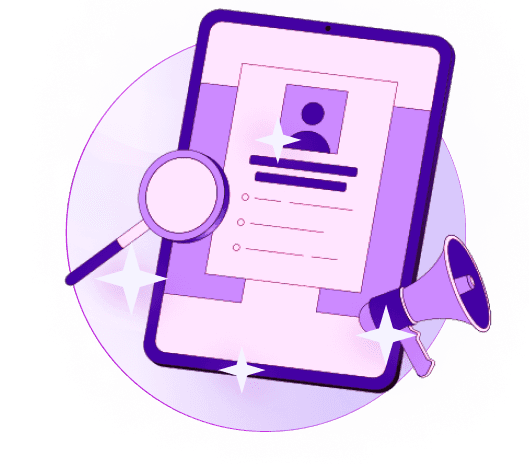Blogs
Articles

Intent Data: What It Is and How to Use Buyer Intent Signals
Bombora Co-op exclusively owns 86% of its websites, which lets them track intent behavior across much of the B2B web.
B2B sales and marketing leaders use intent data to identify prospects ready to make purchases. This valuable resource combines various signals such as website visits, downloaded content, third-party research activities, and company updates including hiring trends. Companies can identify high-potential accounts by analyzing these signals together.
This piece will help you understand intent data comprehensively. You'll learn about its various types, collection methods, and importance in B2B sales and marketing strategy. We'll also show you how to select an intent data provider that matches your needs.
What is Intent Data?
Intent data shows what buyers research online and their chances of making purchases based on the content they consume. Traditional marketing approaches fall short compared to intent data that captures signals when prospects are ready to buy specific products or services. These digital footprints appear as people research solutions through website visits, content downloads, and keyword searches.
How intent data fits into B2B sales and marketing?
Users leave behavioral breadcrumbs as they navigate the digital world. B2B organizations use this intelligence to spot in-market accounts that show early buying signals by analyzing trillions of web interactions. Forrester reports over 70% of companies that use intent data depend on multiple providers to get better coverage and accuracy. Marketing and sales teams can line up their strategies with customer's actual behavior, which results in higher conversion rates and shorter sales cycles.
What are the benefits of intent data?
Companies see substantial benefits from intent data. Research shows 85% of companies that use intent data achieve business benefits.
These benefits include:
Finding prospects who show active interest in your solutions
Giving priority to leads most likely to convert
Creating personalized outreach that addresses specific pain points
Making sales cycles shorter through better lead qualification
On top of that, intent data helps segment audiences better and delivers the right content to the right people at the perfect time. This targeted approach guides companies toward campaigns that work better, with higher conversion rates and better ROI.
What Are the Different Types of Intent Data?
Marketers can target prospects better by learning about different types of intent data. This applicable information exists in multiple forms and each reveals unique patterns in buyer behavior.
First-party vs third-party intent data
First-party intent data comes straight from your own channels your website, CRM, email campaigns, and social media platforms. Your brand's direct interactions with prospects generate this data. Third-party intent data comes from external providers who collect it from websites and platforms everywhere. Companies that utilize both types are 2.5 times more likely to see major increases in sales and revenue.
Search, engagement, firmographic, and technographic signals
Intent signals show different aspects of buyer behavior through distinct categories. Prospects' search terms and phrases reveal their solution research patterns. User interactions with content, such as page views, downloads, and social media activity, create engagement signals. A company's industry and size make up firmographic data. Technographic data shows a prospect's current technology stack this helps identify integration possibilities or spots to replace competitors.
Sources: CRM, analytics, Bombora, bidstream
Multiple sources generate intent data. Your CRM contains valuable first-party signals from sales interactions and email engagement. Website analytics reveal visitor patterns and show which content appeals to prospects. External providers like Bombora gather data through B2B media company partnerships and offer insights from millions of websites. Programmatic advertising creates bidstream data, though cooperative-sourced data proves more reliable.
How is Buyer Intent Data Collected?
Companies track digital footprints from multiple sources to collect buyer intent data. Their sales and marketing strategies benefit from signals gathered through website analytics, third-party platforms, and user activity metrics.
Lead scoring and prioritization
Companies combine intent signals with existing lead-scoring models to identify sales-qualified leads accurately. Sales teams can focus on promising leads by giving higher scores to prospects who repeatedly visit pricing pages, attend webinars, or download product resources. This smart approach directs resources to accounts that show real interest instead of casual browsers.
Personalized outreach and messaging
Sales teams can customize their communication based on observed behaviors through intent data. They can time their contact to match engagement patterns and showcase product features aligned with the prospect's interests. This individual-specific approach increases lead conversions by 55%.
Account-based marketing (ABM) strategies
Intent data helps identify valuable target accounts that show active interest in ABM campaigns. Sales and marketing teams can be more precise in account selection and create touchpoints that align with the digital buying process. Companies that make use of intent-powered ads see 234% faster pipeline progression.
Customer retention and upsell opportunities
Intent signals help spot at-risk customers who research competitors. A Forrester study revealed organizations reduced customer churn by 10% when they used intent data to monitor their customer's competitor research activities.
Why is Intent Data Important for B2B Sales and Marketing?
The numbers paint a clear picture of how intent data matters. Over 85% of companies that use intent data have seen major business benefits. These results explain why 30% of businesses will spend more on these solutions.
Intent data creates competitive advantage in several ways:
Companies can better prioritize prospects who actively research solutions like theirs. This targeted approach explains why 97% of B2B marketers say intent data gives them an edge over competitors.
Sales teams can create personalized outreach that strikes a chord right away by understanding what topics prospects research. This individual-specific approach changes the buyer's experience from generic to relevant.
Intent data helps marketing and sales teams work together better. A tech CEO's words sum it up well - it works like a "GPS for sales strategy" that guides teams to businesses just when they start needing services.
The data shows clear results throughout the revenue cycle. Teams see higher response rates from outbound campaigns and better sales prospecting success. They also report shorter sales cycles, better conversion rates, and smarter resource use.
These benefits make it clear why 70% of companies now use multiple intent data providers to get better coverage and accuracy.
Choosing the Right Intent Data Provider
Your sales and marketing strategy depends heavily on picking the right intent data provider. The market offers many options, and you need to assess each one against specific criteria before committing.
Key features to assess: freshness, accuracy, signal depth
Data accuracy and quality should be your main priority. Check how providers source their data—whether from first-party sources, third-party aggregators, or both. Poor quality intent data wastes outreach efforts and revenue opportunities.
The next step is to assess signal depth. Go beyond simple keyword tracking to find providers that monitor multiple intent signals. These include website visits, content participation, keyword searches, and purchase patterns based on firmographic behaviors. Deeper signals help you spot high-value prospects better.
You must ensure integration with your tech stack works smoothly. Quality intent data should work with your CRM, marketing automation platform, and other sales tools. Even excellent data becomes an isolated information silo without proper integration.
The final step is to think about cost and scalability based on your business needs. Pricing models are accessible to more people, so pick options that line up with your budget and growth path.
Comparison of top platforms: Bombora, ZoomInfo, 6Sense
Bombora excels in intent data through its Data Co-op that tracks content consumption across 5,000+ B2B websites. Their Company Surge® feature spots research activity spikes on specific topics and helps prioritize accounts showing genuine interest.
ZoomInfo combines a big contact database with intent capabilities that identify prospects early in their buying experience. Their platform monitors online activities to detect intent signals and sends live alerts on intent changes.
6Sense provides detailed account-based marketing capabilities with AI-powered predictions that map anonymous buying behavior to specific buying stages. Their platform uncovers both known and anonymous buying signals to spot when prospects are ready to purchase.
To get expert guidance on selecting the right intent data solution for your needs, visit Persana.ai.
What makes Persana intent data unique?
Persana differentiates itself in the crowded intent data space with its AI-powered approach to buyer signals. The platform combines enrichment, verified email finding, intent signals, and company intelligence in one place to create a complete view of prospect behavior.
A proprietary waterfall enrichment system gives the platform its edge. Rather than using just one database, Persana cycles through multiple sources to find contact details. This method improves match rates by a lot and helps sales teams capture all potential leads.
Time is crucial when dealing with intent signals. Research shows that buyer intent data loses much of its value within just one week. The system's design puts "speed to lead" first, which lets teams connect with prospects before competitors and shape the buying journey early.
The platform's AI tools score prospects based on their actual buying behavior and automatically highlight strong intent signals like pricing page visits or demo requests. Sales teams can tailor their outreach when they know exactly what topics interest their prospects.
Companies can tap into the full potential of their intent data strategy at Persana. The AI-powered tools help teams spot and respond to buyer signals faster than their competition.
Conclusion
Intent data has without doubt changed how B2B sales and marketing teams find and participate with high-value prospects. This piece explores how digital breadcrumbs show buyer behavior. Teams can now focus on accounts that show genuine purchase intent rather than cold prospects.
Companies that properly use intent signals get a most important edge through improved lead prioritization, individual-specific outreach, and analytical ABM strategies. The mix of first-party and third-party data gives a complete view of prospect behavior on and off your owned digital properties.
The right intent data provider will definitely make all the difference to your sales success. Data freshness, signal depth, integration capabilities, and affordable solutions should guide your evaluation of options. Your team must carefully assess whether providers like Bombora, ZoomInfo, or 6Sense match their specific needs.
Persana's unique AI-powered approach sets it apart. It combines multiple data types into a single platform and ensures maximum speed-to-lead benefits. You can visit Persana to find how their waterfall enrichment system can boost your match rates and intent-driven sales outcomes dramatically.
Note that intent data loses much value within just one week after collection. Teams that act quickly on these signals ended up winning more deals by reaching prospects during active research phases. The right intent data strategy will change your sales approach from hoping for conversions to confidently pursuing prospects already moving toward purchase.
FAQ
What makes a good intent data provider?
Quality intent data providers deliver several essential attributes. The solution-level modeling separates similar products rather than simple category modeling. These providers identify intent through job characteristics like titles and seniority that help create targeted personas. The provider should go beyond simple data collection and deliver analytics capabilities to identify and prioritize marketing or sales actions. Data security features play an equally vital role - choose providers that offer complete transparency about data usage and clear opt-out paths.
Is Bombora GDPR compliant?
Yes, Bombora follows GDPR compliance among other major data protection regulations including CCPA. Their data collection comes from a Co-op network of 5,000+ B2B publishers and websites. The company removes user-identifiable information, then creates total and anonymous data before linking it with company domains. Bombora's data comes ethically from their trusted network, not from scraped ads like some competitors.
Who sells intent data?
The intent data marketplace has various provider types. G2 lists many verified buyer intent data providers with thousands of user reviews. Major players operate in four business models: traditional data providers, ABM platform providers, campaign execution firms, and walled gardens. Prominent options like Bombora, ZoomInfo, 6Sense, and others take different approaches to data collection and delivery.

Create Your Free Persana Account Today
Join 5000+ GTM leaders who are using Persana for their outbound needs.
How Persana increases your sales results
One of the most effective ways to ensure sales cycle consistency is by using AI-driven automation. A solution like Persana, and its AI SDR - Nia, helps you streamline significant parts of your sales process, including prospecting, outreach personalization, and follow-up.



